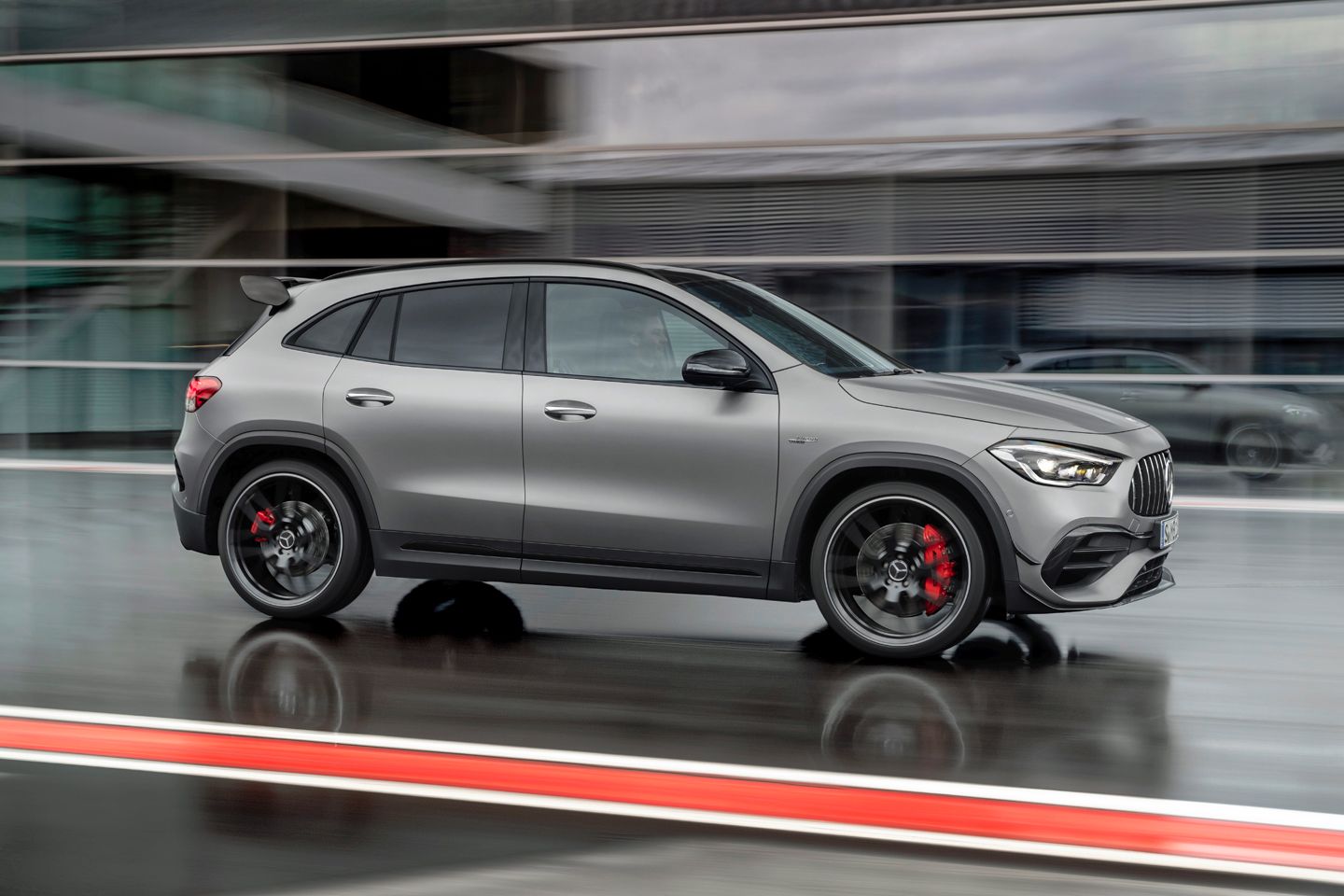Key considerations
- Available for £37,000
- 2.0-litre inline-four petrol twin-scroll turbo, all-wheel drive
- Insane 400hp+ power and safe AWD handling in a practical body
- Lots of toys to play with, which could mean aggro down the line…
- …but the gen-two car has been very reliable so far
- A genuine sleeper for the 2020s
When SUVs first began to populate our streets in a serious way the ‘Sports’ part of the Sports Utility Vehicle name was derided as a weak joke. It was a pity that the new genre had such a difficult birth in the eyes of many motoring enthusiasts because nowadays most of us are entirely comfortable with the SUV concept, manufacturers having successfully invested SUVs with speed, all-wheel traction and the kind of handling that cynics thought couldn’t possibly be engineered into high-stanced cars. They got around the PR false start by creating another class which they called the crossover and hey presto, SUVs and credibility could finally be mentioned in the same sentence.
Porsche was quick out of the sports crossover blocks with its 2014 Macan. The base model’s 2.0-litre turbo four made a respectable 249hp. You could have 340hp in the S model but a 3.0-litre twin-turbo V6 was needed to get it. Both Macans were made to look anaemic by Mercedes-AMG’s own 2014 entrant, the GLA45 4MATIC AMG which banged out an unlikely 360hp and 332lb ft from its new M133 2.0 four. With a Speedshift 7G 7-speed twin-clutch gearbox that was enough firepower to hurl it through the 0-62mph run in 4.8 seconds. The default handling on a chassis that rode 40mm higher than the A45 hatch’s (but 15mm lower than a standard GLA) was a good compromise of comfort and precision. If it wasn’t sharp enough you could always tick the box for AMG’s Performance suspension.
That wasn’t the end of the story either. In 2015 the GLA45’s power was raised to 381hp to smack down the challenge of Audi’s RS Q3. With lots of popping and parping from the optional sports exhaust and the claim of nearly 38mpg in average use the GLA45 represented an appealing (if expensive) do-it-all transport choice for the well-dressed hooligan about town.

The gen-one was discontinued in 2019 but there was more to come. The gen-two that’s the subject of this week’s buying guide was released a year later, its MFA2 platform supporting a new M139 engine. That was still a 2.0 turbo four, which in base trim had 382hp, but in S format – the only model made available to UK buyers – it pumped out 421hp, making it the world’s most powerful series production turbo four-pot engine and the GLA45 S the world’s most powerful compact crossover. Incredibly, there was plenty of tuning headroom. In the 2022 C63 S E Performance the M139i engine produced a whopping 476hp and 402lb ft – still from a 2.0 litre four.
Mating the 421hp M139 to Mercedes’s new Speedshift 8G 8-speed dual-clutch gearbox chopped the GLA45 S’s 0-62mph time by half a second to 4.3sec. The 155mph limiter was removed too, lifting the top speed to 168mph. For the new car the 4MATIC+ all-wheel-drive system included electronically-controlled individual multi-plate clutches on each rear wheel to allow torque to be accurately vectored to the most receptive side of the car, as well as the normal front to back apportionment. Model-bespoke suspension tweaks were added to improve on-the-limit controllability and reduce torque steer. A new Race Start mode provided launch control and ‘more noticeable’ gearshifts, these being apparently deemed desirable in this class of vehicle.
It all seemed to hit the mark. In terms of driver entertainment, reviews showed that the GLA45 S really wasn’t that far off the equivalent A45 and CLA45, a remarkable achievement given the excellence of the A45 in particular and the lingering perception of the GLA as a tall vehicle leaning almost literally towards function more than form.

You had to pay for the privilege though. The normal gen-two S, which as stated was the only model you could buy in the UK, was priced at £58,775. That put it up against the Macan GTS at just under £59k and Audi’s five-pot RS Q3 Sportback which was just under £54k. The loaded-up Plus version of the GLA – wheels upsized from 20 to 21 inches, adaptive dampers, adaptive LED headlamps, aero package with roof spoiler, pano roof, ’multi-contour’ electric seats, two additional driver assist features and a Burmester sound system – was even less of a budget purchase at £64,775.
There was a midlife facelift earlier this year (2024) which involved the usual reworking of the lights front and rear plus a new MBUX infotainment system. In addition, the dual 10.3-inch screens of the old model’s Premium Package became part of the standard offering. As of July 2024 the entry price for a used gen-two M139 GLA45 S was a little over £37,000. That would buy you a ’20 or ’21 car with around 30,000 miles on it.
SPECIFICATION | MERCEDES-AMG GLA45 S 4MATIC (2020-on)
Engine: 1,991cc, four-cyl turbo
Transmission: 8-speed dual-clutch auto, all-wheel drive
Power (hp): 421@6,750rpm
Torque (lb ft): 369@5,000-5,250rpm
0-62mph (secs): 4.3
Top speed (mph): 168 (limited)
Weight (kg): 1,690
MPG (official combined): 25.4
CO2 (g/km): 211
Wheels (in): 20 (Plus 21)
Tyres: 255/40 (Plus 255/35)
On sale: 2020 – on
Price new: £58,775 (Plus £64,775)
Price now: from £37,000
Note for reference: car weight and power data are hard to pin down with absolute certainty. For consistency, we use the same source for all our guides. We hope the data we use is right more often than it’s wrong. Our advice is to treat it as relative rather than definitive.
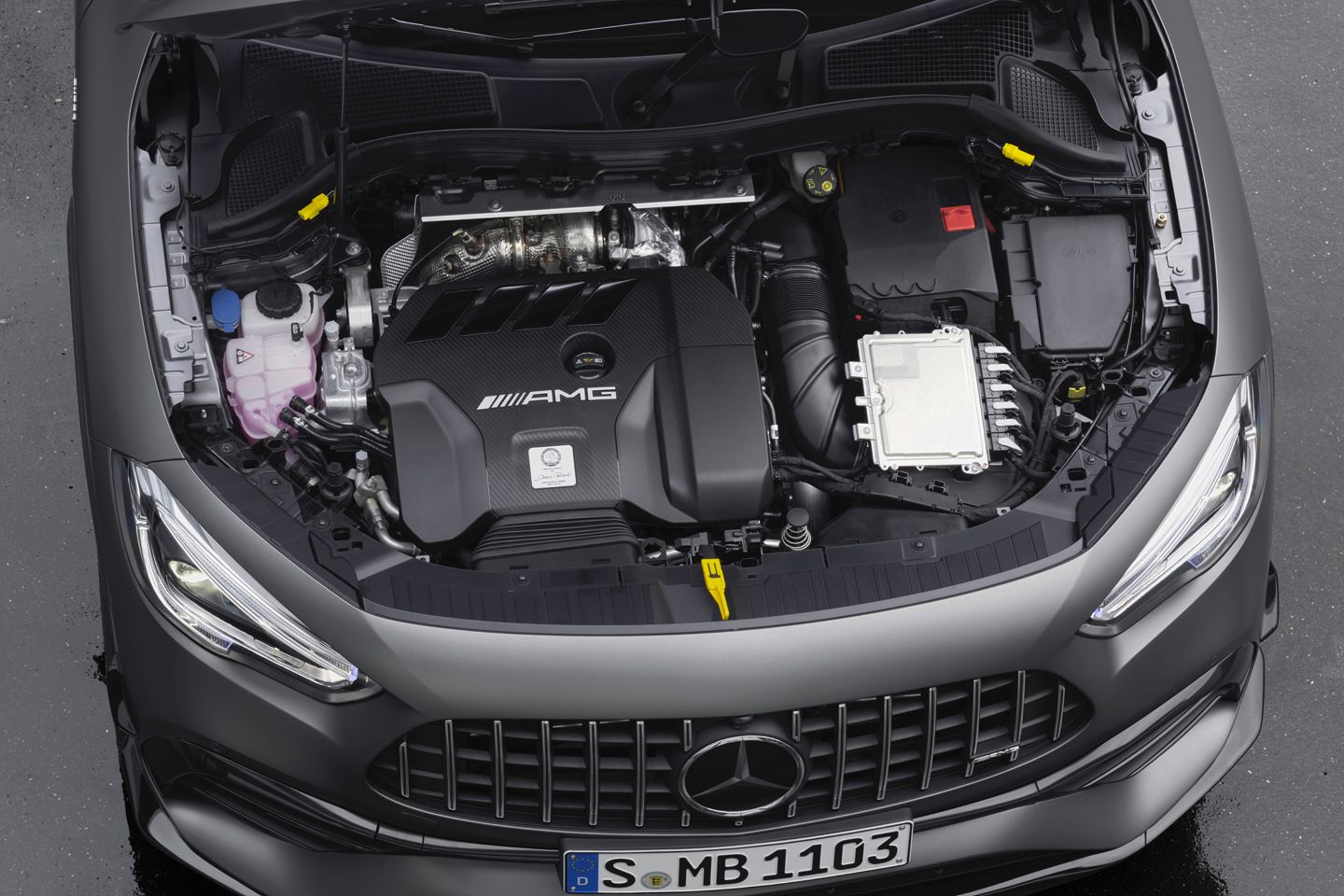
ENGINE & GEARBOX
The GLA45’s two-stage port- and direct-injected M139 engines were hand-assembled on AMG’s Affalterbach line according to the ‘One Man, One Engine’ principle. Before you ask, we don’t know if any Women were involved in that process. Maybe somebody reading this will know and can advise.
By rotating the block by 180 degrees and thereby repositioning to the back of the engine the hardware for the exhaust headers and the electrically-assisted, low-friction, roller-bearing twin-scroll turbocharger, the flows of air and gas into and out of the engine were shortened and straightened and the bonnet profile was kept efficiently low. Not only was the injection two-stage, so was the cooling. The cylinder head was conventionally cooled by a mechanical water pump and the crankcase by an on-demand, ECU-controlled electrical pump.
There’s a limit to how much power you can get from a small engine, even a turbocharged one, without using a lot of revs and the M139 fitted that stereotype. Its powerband was closer to that of an old-school naturally-aspirated engine than a modern turbo unit. By comparison with a typical one of those, the M139 could feel laggy at lower rpm, especially if you were attempting a fast start away from the lights in any of the non-launch control modes. If you wanted all the power you had to build up to the full charge pressure of 2.1 bar and you had to have 6,750rpm on the tacho.
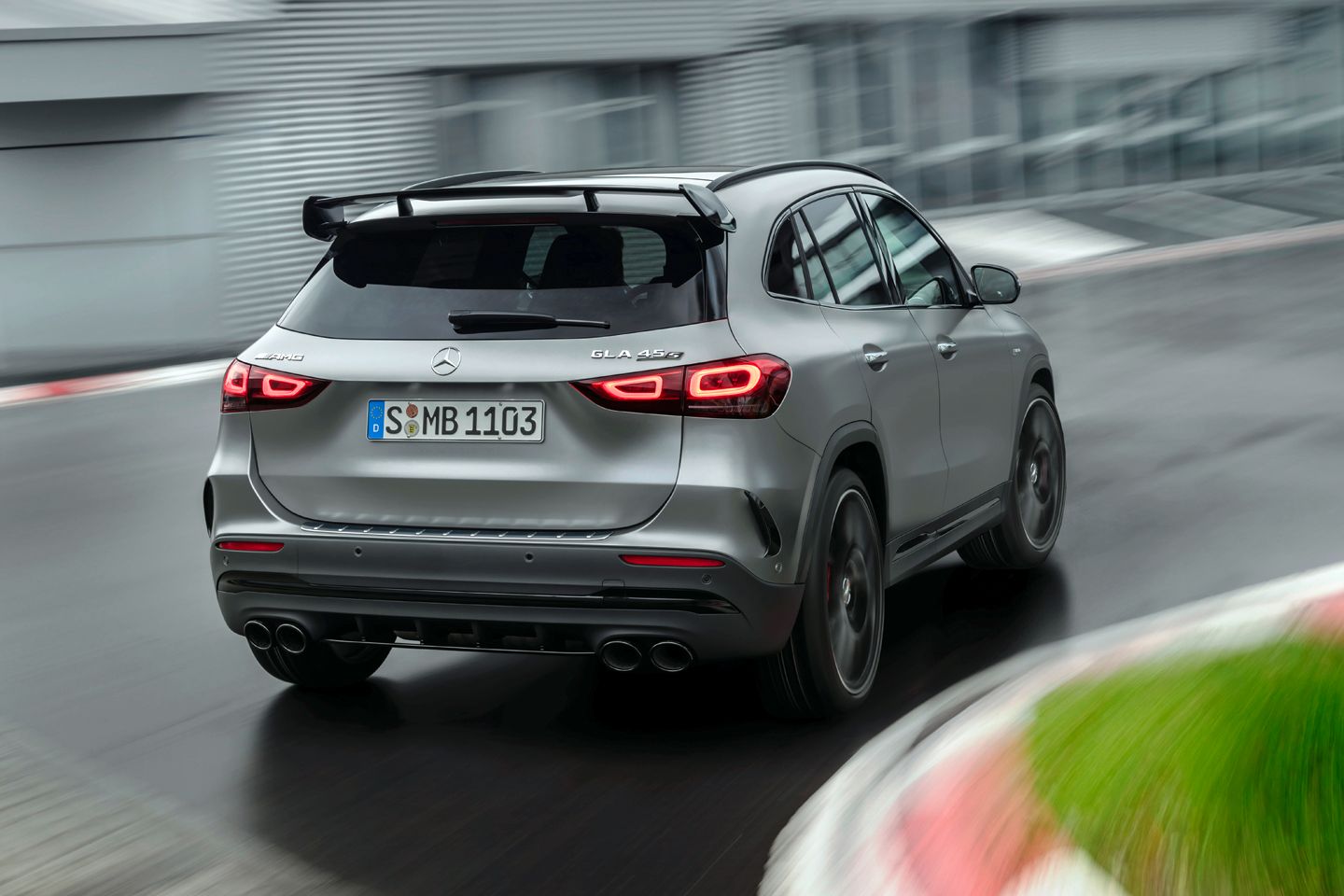
Similarly, the torque peak that didn’t arrive until 5,000rpm was on the way back down again 250rpm later. In reality of course you didn’t need anything like these peak outputs to make very rapid progress across the land as even 75 per cent of 400hp was still 300hp, i.e. a lot. Unsurprisingly, economy took a back seat. The official fuel consumption of around 25mpg might sound poor, but the difficulty of resisting full throttle openings everywhere means that you will come to see that as a positive target. Figures in the low 30s are possible if you can exercise extreme restraint. In that kind of ‘normal’ driving the GLA45 could seem smoother than the A45.
Two intensities of exhaust noise were available, ‘Balanced’ in the comfort-oriented modes or ‘Powerful’ in the Sport+ and Race modes. Real Performance Sound – real engine sounds picked up by a mic and amplified through the speakers – was a poppin’ and bangin’ option that didn’t annoy bystanders. Turbo whistle on acceleration was perhaps the best GLA45 S noise of all.
Normally there is no shortage of common problems to talk about on any production car, even (or especially) on high performance ones like this, but the only negative comments we could find on the GLA45 S’s powertrain were to do with marginal batteries, a problem which is far from unique to this vehicle. Fixed-price servicing at an independent like Pieperformance costs £260 for an “A’ and £365 for a ‘B’.
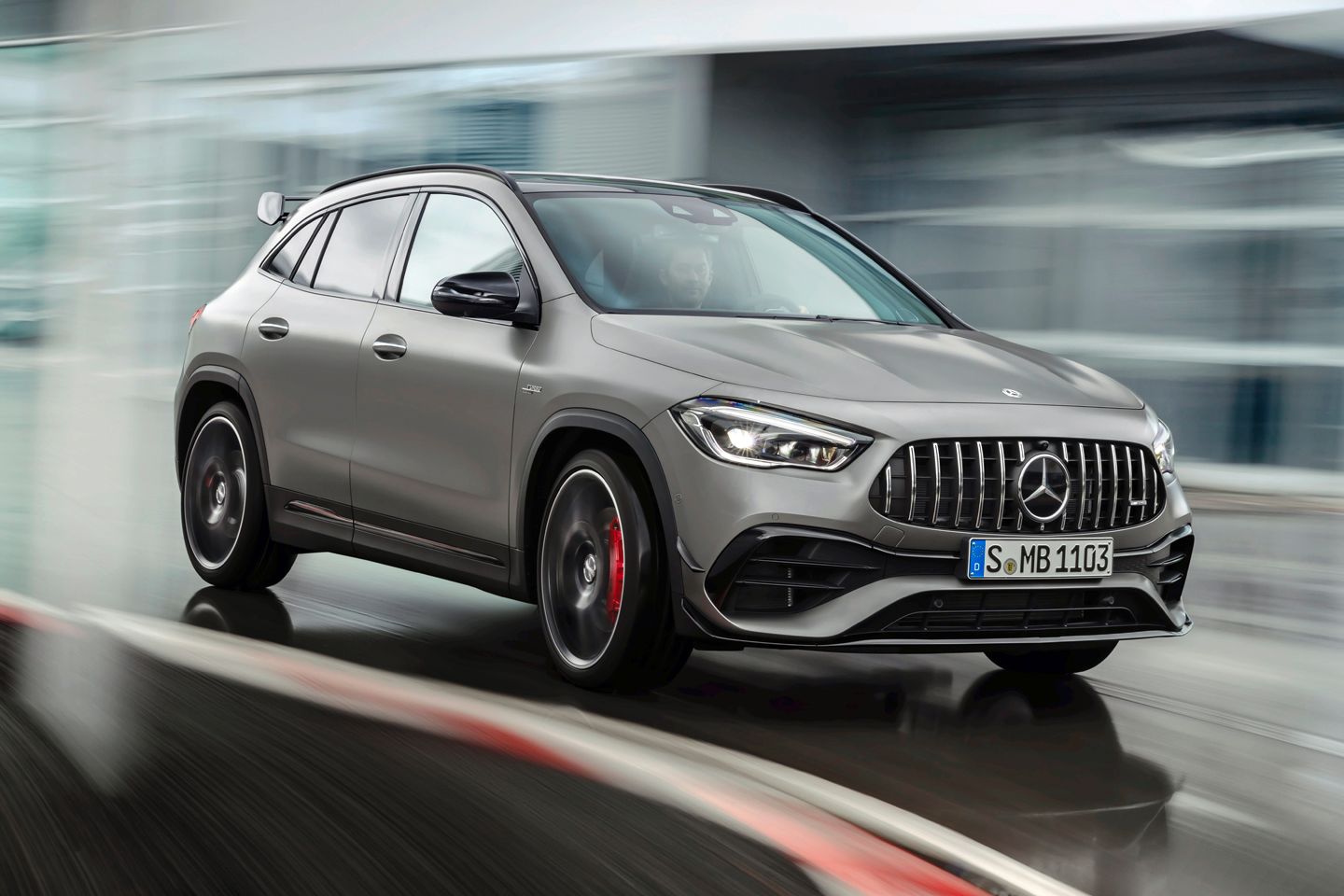
CHASSIS
Appearances can be deceptive. The GLA45 S was 140kg heavier than the A45 S but although it looked physically larger than the CLA45 S Shooting Brake it was reportedly 15kg lighter. Although it looked like a crossover, because that’s what it was, there was surprisingly little difference between the various 45 formats in terms of how quickly they went around corners and how hard they gripped the road surface.
The GLA’s suspension layout was conventional but beefed up, featuring MacPherson struts at the front with aluminium wishbones and a rigidly connected four-link rear. Bespoke to the car were AMG springs and three-mode dampers. Three driver modes were supplemented on the UK S-spec cars by a fourth Race setting which slackened off the driver aids and put more power through to the back end.
The variable-ratio steering was electrically assisted. All-wheel drive characteristics were dependent on the driving mode and the S’s AMG DYNAMIC PLUS settings. In Basic and Advanced, the 4MATIC system was in Comfort mode. In Pro and Master it switched to Sport mode. There were six Dynamic Select drive programmes ranging from Slippery to Race. A ‘glide’ function was available in the Individual driving mode.
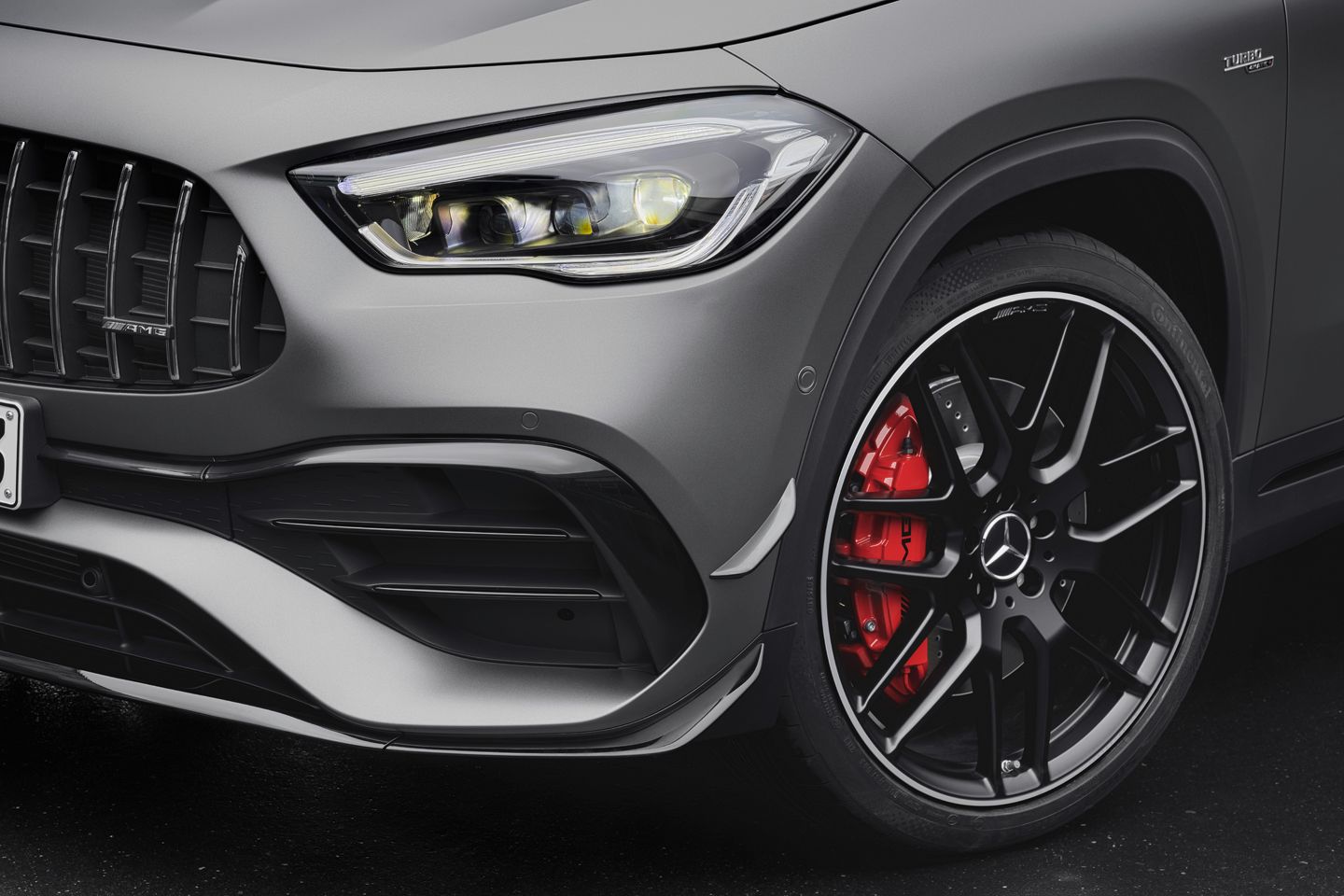
The GLA’s rear diff did a great job of boosting mid-bend pivotability. Even in Comfort mode body control was impressive, making the more extreme modes largely redundant. The A45 S was a more focused machine, so on head-to-head timed laps it would beat a GLA45 S, but the margin of victory wouldn’t be as wide as you might think. On normal roads where ground clearance was an issue the GLA would more than hold its own.
20-inch wheels were standard on the UK’s S model, with 21s as an option. Although the brakes were enlarged for the gen-two car to 360mm front (six-piston red calipers) and 330mm rear (single piston) they could still look a bit small if you were running the 21-inch wheels. The brakes could also be quite noisy in light pedal applications.
There have been isolated reports of 4MATIC difficulties (not specific to the GLA45 S) which have resulted in the car failing to start, being stuck in gear and refusing to be pushed. The first warning comes up as ‘currently unavailable’ followed by a red one giving you an instruction to ‘without changing gear, consult workshop’. This was diagnosed by one dealer as the ignition key not being recognised, with quite a few other comms faults being found. The owner of this car (which actually was a GLA45) was advised to use the ignition key to start the car rather than the push button should the problem occur again. It did exactly that three months later, the ‘currently unavailable’ and ‘consult workshop’ warnings illuminating once more and stranding the owner again. On both occasions the weather was very wet, but that might have been a simple coincidence. On both occasions the car managed to reset itself but only after a 24-hour rest.
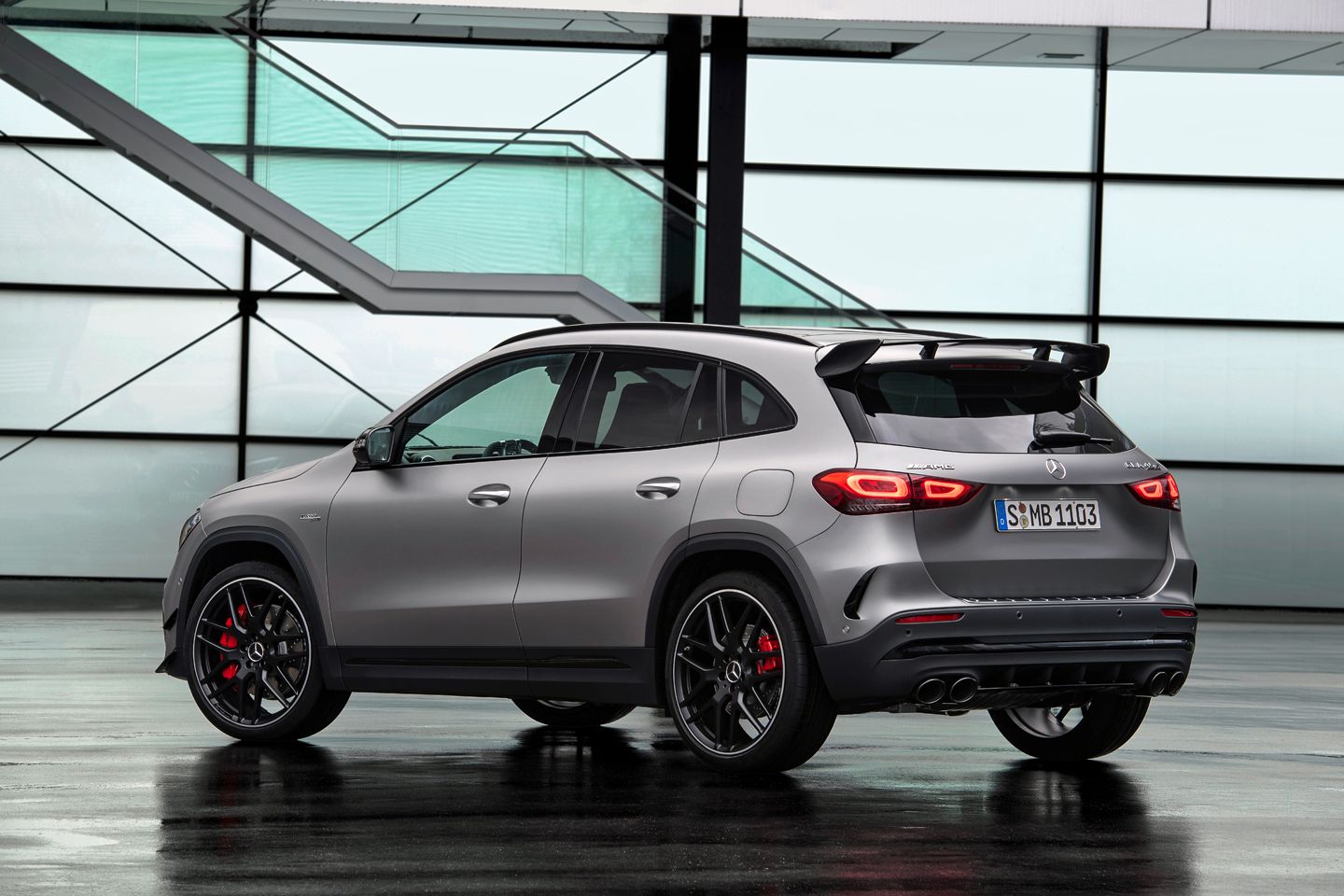
BODYWORK
Bonnet bulges, big wheel arches and gaping air intakes visually marked the 45 out from lesser GLAs. A lightweight aluminium plate bolted underneath the engine added rigidity to the front end. Some fuel flaps on GLAs (normal non-AMG ones) have been known to throw up ‘fuel flap open’ warning messages, sometimes culminating after a few owner shuts in the flap’s complete failure to close.
LED headlamps were standard. There was a recall on 2022 cars for incorrectly adjusted lights. That was for non-S models in the US though, so might not apply to UK cars. The feature of automatic switching between high and dip beams was welcome but it could operate in a random manner. The 435-litre boot wasn’t very deep, as you’d expect from an AWD car, but its good width made it a useful space for a couple of big old suitcases plus the usual selection of squidgier luggage.
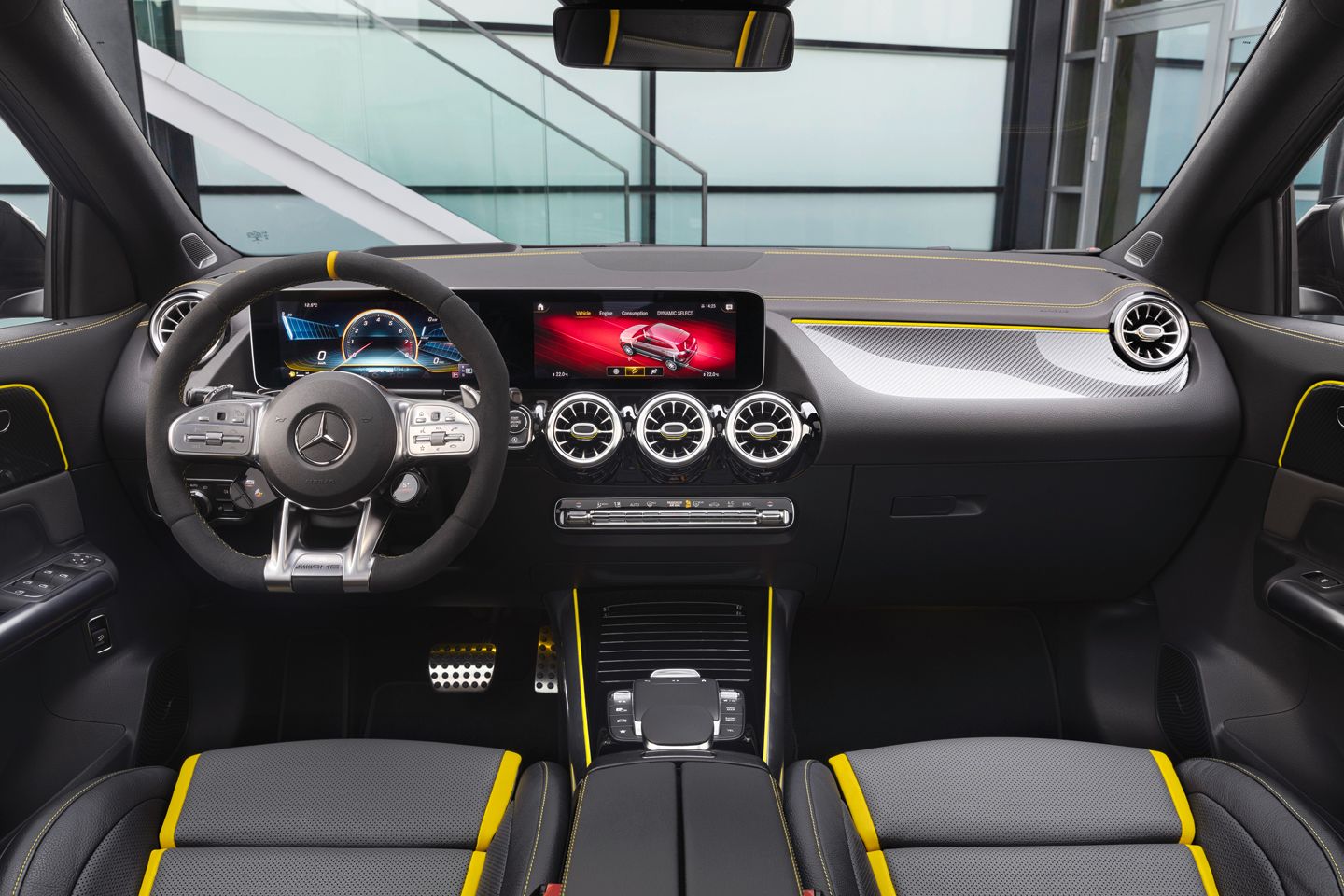
INTERIOR
The GLA’s sports bucket seats in a mix of Artico artificial leather and Dinamica microfibre were the same as the ones found in the A and CLA45 models. AMG Performance seats were optional. The extra height of the GLA’s body somewhat eased entry to any of its seats. That body height also enhanced visibility and the rear-seat experience by adding vertical leg space, allowing six-footers to spend many an hour in there without complaint. The downside was a driving position that was slightly higher than in the non-crossover models, which naturally reduced the sportlicher feeling. Some found that the seat padding was on the hard side of firm and that lateral support for your butt in the non-Performance seats was less than great.
Key AMG features were carried over to the GLA45 S like the nice Nappa leather/Dinamica Performance steering wheel with its mode knob. The voice-controllable ‘Hey Mercedes’ MBUX infotainment system was one of the two displays located under a single glass cover to create a widescreen effect. One of the three display options, Supersport, gave you a central tachometer with ‘3D’ info bars on either side with lots of supplementary info displays for g-force and the like. The S-standard Track Pace virtual race engineer monitored over 80 data fields and gave you F1-style colour-coded lap times so you could immediately see if your latest lap was quicker than the one before. An augmented reality function showed you the best lines on stored tracks. These could be displayed on a colour head-up display that (we think) was part of the S spec. Pretty spiffy.
As can often be the case with firmly-suspended cars, the GLA45’s cabin was not rattle-free in either gen-one or gen-two iterations. Other unwelcome noises could include seatbelt warnings on startup for unoccupied rear seats, the infotainment’s repetitive ‘how can I help you?’ beseechings, and tyre roar that could become tyre-some on rougher roads. Luckily the hardcore Karman Hardon (some mistake surely) audio system was more than capable of drowning out everything. The active cruise control worked really well too and 70mph was delivered at a relaxed 1,500rpm in top gear. The backlit air vents on the ends of the dash could reflect distractingly in the side windows, compromising your view of traffic behind in the side mirrors.
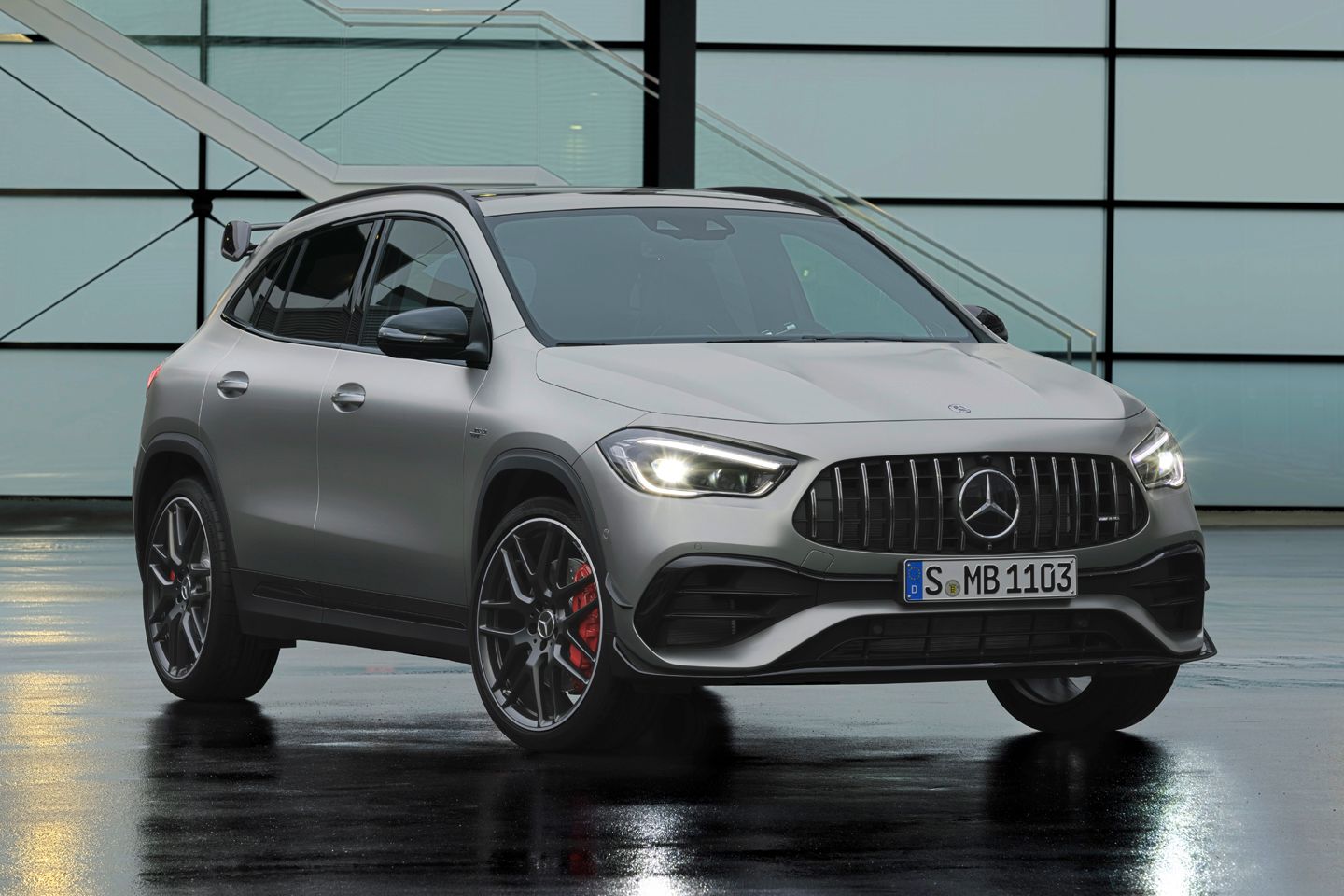
PH VERDICT
The gen-two GLA45 S was a practical version of the barnstorming A45 S. Audi’s RS Q3 arguably looked better but wasn’t as quick, and nor was any 2.0-litre four-pot Porsche Macan. The AMG was a perfect car for any family with an all-year pass to Alton Towers and a desire to extend the rollercoaster screaming experience to take in the journey there and back. A bit niche, you might say, but others might say that’s what makes it special.
Unlike the hatch, the GLA had no drift mode, but that would probably be a step too far in a crossover. If you were desperate you could get the back end moving around by going for max disable on the driver aids. In driving scenarios that were on the safe side of sane the GLA’s chassis was all but foolproof. Any perceived reduction in bend-swinging excitement in the GLA was more than made up for by its mad straightline performance.
These cars were packed with tech, which is great when it’s all working but not so great when it isn’t. Fortunately, the gen-two GLA45 S’s reliability reputation seems to be very good indeed so far. Apart from one that very possibly didn’t apply to UK cars anyway there have been no recalls that we’re aware of. Maybe there’s something in that AMG build philosophy of ‘one bod, one car’.
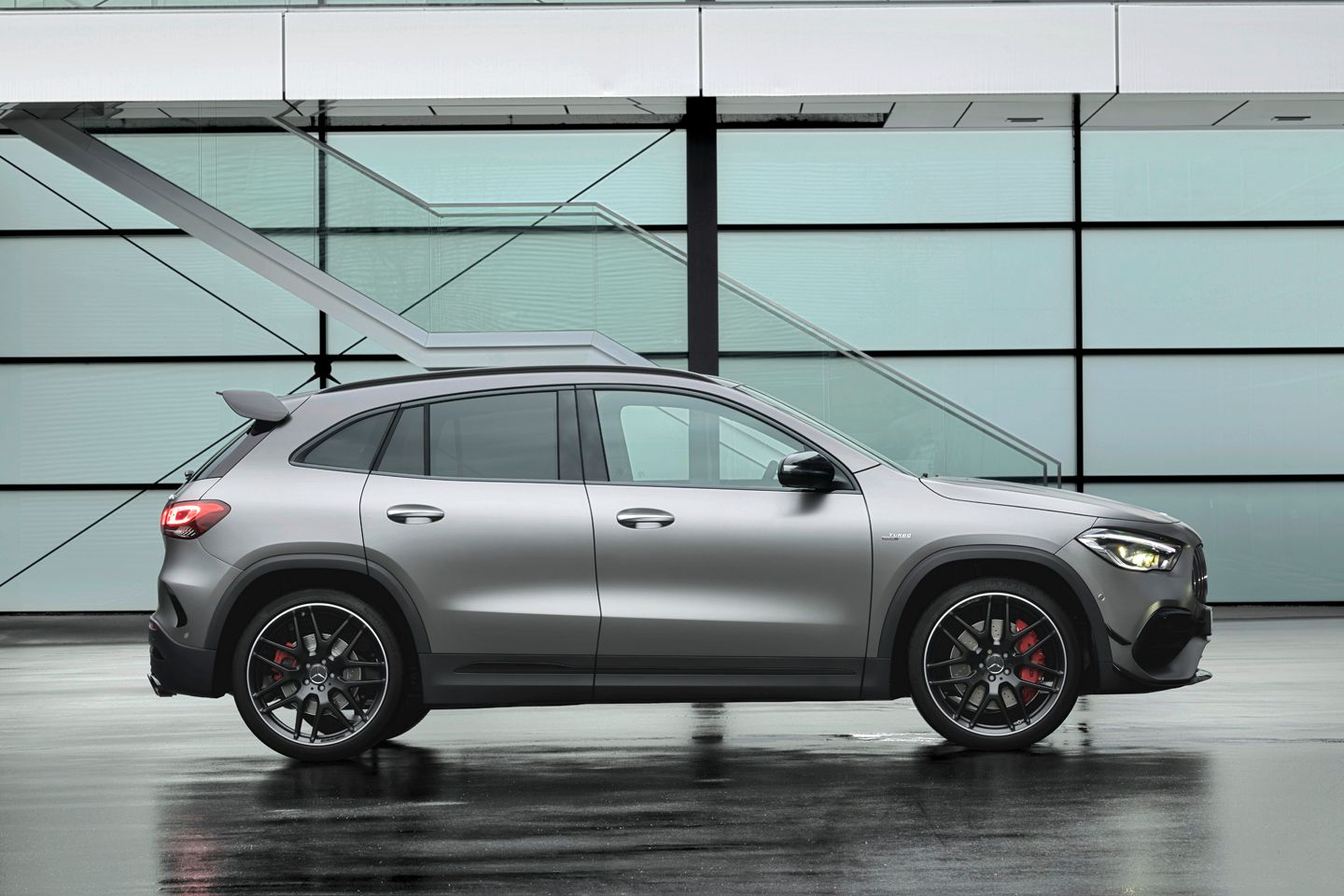
Having said that, a few other marques that shall remain nameless have gone down that route, and not always with the best success. Some of the engineers outside AMG who have signed engine covers in the past are now maybe wishing they hadn’t.
Which one should you buy? Well, as usual with any AMG, buyers seemed determined to go for the gangster look in all black with the rubber-band tyres. This seems like an odd choice for something like a GLA. For a much more fun Q-car vibe you’ll be wanting a non-Plus car without the 21-inch wheels or the full rear spoiler aero package, and ideally painted in a suitably unassuming colour. Something like this ’22 specimen in red with 7,000 miles at just under £46,500.
The most affordable gen-two GLA45 S on PH Classifieds at the time of writing (July 2024) was this 2021 32,000-mile Plus car from the Benz Approved Used scheme at £42,500. That was £4,000 less than the next cheapest of the other 14 cars available on PH at the time, the majority of which were in the £51k-£52k bracket. You could pay £56,000 for a choice of two Approved Used Plus cars, one with 1,350 miles and roof spoiler, the other with under 300 miles and no spoiler.

